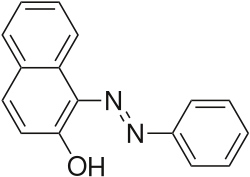Staining
Sudan dyes have high affinity to fats, therefore they are used to demonstrate triglycerides, lipids, and lipoproteins. Alcoholic solutions of Sudan dyes are usually used, however pyridine solutions can be used in some situations as well.
Sudan stain test is often used to determine the level of fecal fat to diagnose steatorrhea. A small sample is dissolved in water or saline, glacial acetic acid is added to hydrolyze the insoluble salts of fatty acids, a few drops of alcoholic solution of Sudan III are added, the sample is spread on a microscopic slide, and heated twice to boil. Normally a stool sample should show only a few drops of red-orange stained fat under the microscope. The method is only semiquantitative but, due to its simplicity, it is used for screening.
This page is based on this
Wikipedia article Text is available under the
CC BY-SA 4.0 license; additional terms may apply.
Images, videos and audio are available under their respective licenses.






